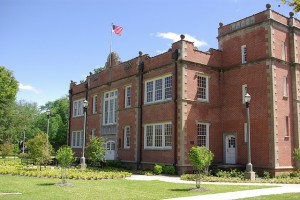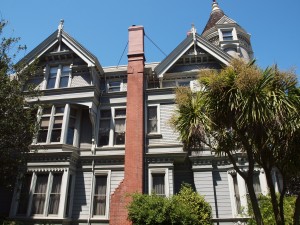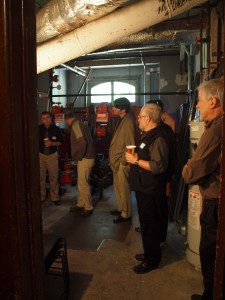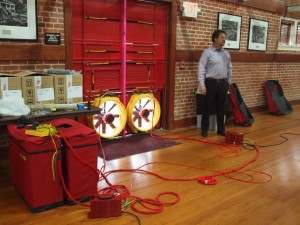
Lee H. Nelson Hall, the headquarters of NCPTT in Natchitoches, LA is undertaking the completion of a Sustainability Management Plan. Photo courtesy NCPTT.
I get calls and emails all the time from owners who say that they really want to “green” their buildings but don’t know where to start. Or owners who say “My architect told me that historic buildings just can’t get LEED certification, because we don’t want to replace our windows, or we can’t change the insulation, or we can never meet the ASHRAE requirements…” There are so many misunderstandings and misconceptions about “greening” existing buildings, and many of those misunderstandings sadly are promoted by other design professionals. The first thing I say is that every building is different. The needs of every owner are different. LEED is a tool like any other tool – it works for some projects but not for others. The key thing is to hire a team of professionals with experience in “greening” historic buildings because often you might just have the wrong team for that project.
Many owners understand that in order to improve the energy efficiency of their building, they need to have an energy audit conducted. But few people realize that energy is only one of the resources impacting climate change. I have been working on “greening” historic and existing buildings for much of my career and have developed “The Greening Plan” an audit created specifically to evaluate all of the resource use in a building including – water, electricity, lighting, cleaning products, landscaping etc. Sometimes it’s just a one-page outline to get started or a comprehensive sustainability management plan. Two historic sites on opposite sides of the country, both listed in the National Register, are in the midst of upgrading their buildings, starting with a sustainability management plan and eco-charrettes.
How To Green a House Museum

The Haas-Lilienthal House in San Francisco is hoping to be the first house museum to get LEED certified.
The Haas-Lilienthal House, a pristine 1886 Victorian mansion with most of its contents intact, was designed by renowned Victorian architect Peter Schmidt, for members of the Haas and Lilienthal families, who were among the city’s most prominent early residents. Listed in the National Register of Historic Places in 1973, and designated a San Francisco Landmark in 1975, it is an exuberant example of the Queen Anne style.
BAC/A+P developed “The Greening Plan,” a Sustainability Management Plan for the house museum whose baseline target was to implement much-needed capital improvement projects while overhauling maintenance and stewardship policies and procedures.
A guiding premise of the Plan was that the House should meet energy and sustainability goals while preserving its character-defining and historically significant features. As a traditional building, the project evaluation was initiated by identifying and leveraging the original design features that contribute to the management of heat, air and light in the building. Each recommendation was evaluated against whether it could save energy and material resources, while respecting character-defining elements.

Eco-charrette participants tour the original mechanical room in the basement of the Haas-Lilienthal House.
Recommendations for the strategic approach include steps to be implemented sequentially or in tandem depending on the construction schedule and funding campaign, including capital improvements, phased construction, energy audit, weatherization, development of a green housekeeping program, LEED-based maintenance and operations, major rehabilitation, and Net Zero goals. The project has been presented at major conferences such as the AIA and Greenbuild as an example of sound sustainable preservation management policies using LEED EB O&M. The owner, San Francisco Architectural Heritage, is currently in the midst of their fundraising campaign for the project and intend to start design and register for LEED certification soon. The completed Sustainability Management Plan can be downloaded from San Francisco Architectural Heritage’s website.
Using Your Own Building to Create a Model of Sustainability
Lee H. Nelson Hall in Natchitoches, LA was originally constructed in 1923 and designed by the firm Favrot and Livaudais, architects who were responsible for numerous downtown New Orleans buildings, and other public buildings around Louisiana. The structure served as a classroom building and activity center for female physical education students on the campus of what is now Northwestern State University (NSU). Once the Hall was no longer large enough to serve the student body, it was closed, and its uses were moved a new building that was completed in 1970.
After 30 years of use as a storage facility, a new department of the National Park Service, the National Center for Preservation Technology and Training was located in the building in 2001. The goal of NCPTT is to “use technology to serve the future of America’s heritage through applied research and professional training.”

Gordon Shepperd of Apollo BBC explains how the whole building blower door test will help us evaluate the energy loss in Lee H. Nelson Hall.
BAC/A+P in joint venture with Apollo BBC from Houston is developing and managing, “The Greening Plan,” a Sustainability Management Plan for the building which includes running eco-charrettes and conducting an energy audit to achieve the following goals of NCPTT:
1. Improve the energy and resource performance of the Lee H. Nelson Hall and decrease the costs of utility bills.
2. Provide training to NCPTT staff which engages them in the sustainable stewardship decisions for the building and site, and provides experience with LEED EB:O&M and the eco-charrette format.
3. Advance the leadership role of NCPTT in sustainable stewardship and preservation by providing a model project for “greening” the maintenance procedures of NCPTT’s historic building.
The first goal-setting eco-charrette was conducted in January and the full plan should be completed by the end of the summer. The whole team hopes that as more projects like these are completed, the comment that “greening your historic building just can’t be done,” will be heard less and less.
And if you’d like to “subscribe” or follow my blog, True Green Cities, please sign up through the “Subscribe” button at the bottom left of this page. You’ll receive a daily recap when new blogs are posted. Or Sign up for the Feed.
